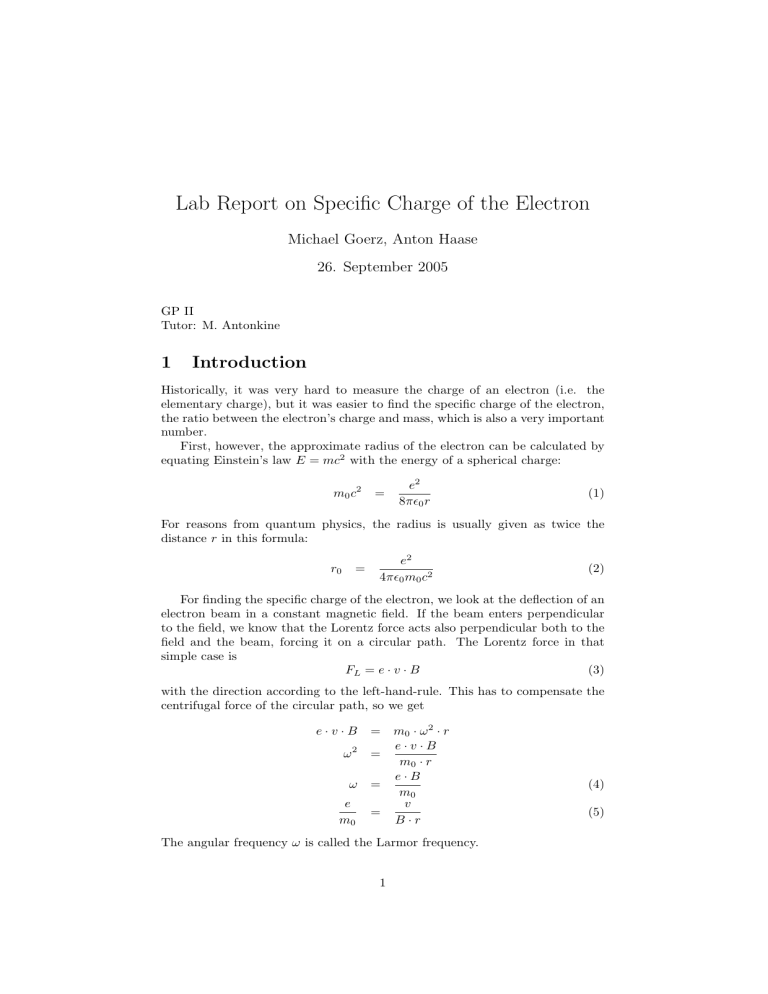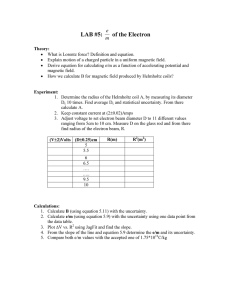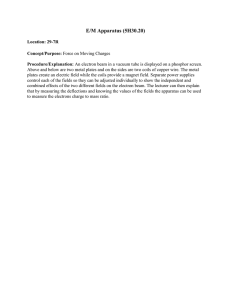
Lab Report on Specific Charge of the Electron Michael Goerz, Anton Haase 26. September 2005 GP II Tutor: M. Antonkine 1 Introduction Historically, it was very hard to measure the charge of an electron (i.e. the elementary charge), but it was easier to find the specific charge of the electron, the ratio between the electron’s charge and mass, which is also a very important number. First, however, the approximate radius of the electron can be calculated by equating Einstein’s law E = mc2 with the energy of a spherical charge: m0 c2 = e2 8π²0 r (1) For reasons from quantum physics, the radius is usually given as twice the distance r in this formula: r0 = e2 4π²0 m0 c2 (2) For finding the specific charge of the electron, we look at the deflection of an electron beam in a constant magnetic field. If the beam enters perpendicular to the field, we know that the Lorentz force acts also perpendicular both to the field and the beam, forcing it on a circular path. The Lorentz force in that simple case is FL = e · v · B (3) with the direction according to the left-hand-rule. This has to compensate the centrifugal force of the circular path, so we get e·v·B ω2 ω e m0 = m0 · ω 2 · r e·v·B = m0 · r e·B = m0 v = B·r The angular frequency ω is called the Larmor frequency. 1 (4) (5) GP2 - SPL Goerz, Haase Experimentally, we need to know both the electron beam’s velocity v and the magnetic field B. The electrons are generated in an electrode and are accelerated by passing through a potential difference U , which, according to energy laws, gives them the following velocity: e·U ⇒ v2 1 mv 2 2 = e 2·U · m0 = (6) (7) This we can enter in Eq. (5) squared, giving us e 2U = 2 2 m0 r B (8) The magnetic field is generated by a pair of Helmholtz coils. If properly set up, this system of coils with radius R each produces a nearly homogeneous, isotropic magnetic field at the position z = 0 exactly between them. B0 = n · µ0 √ 8 I 125 R (9) If necessary, a correction in the form of a Tailor series can be made to this field, depending on the z and r coordinate. The components in z and r direction are ½ · 4 ¸ ¾ 48 r r2 z 2 z4 Bz = B0 1 − 3 4 − 24 2 2 + 8 4 + . . . (10) 125 R R R R · 2 ¸ ¾ ½ z r2 72 r z 4 2 − 3 2 + ... (11) Br = B0 125 R R R R In general though, this will not be needed. Now, form Eqs. (8) and (9), we can write the formula including all the quantities that can be measured in the experiment. µ ¶2 e 125U R = (12) m0 32 r · n · µ0 · I In the experimental setup, the electron beam and the magnetic field are enclosed in glass together with low density hydrogen gas to make the beam visible and to keep it focused. The literature values for all the relevant quantities are r0 e/m0 = = e = m0 = 2 2.8179378(70) · 10−15 m 1.7588115(24) · 1011 C/kg 1.6021829(22) · 10−19 C 9.109464(99) · 10−31 kg Assignment Determine the specific charge of an electron e/m0 by measuring the deflection of the electron beam in a magnetic field. 2 GP2 - SPL 3 Goerz, Haase Analysis In order to find the specific mass of the electron, we go from Eq. (12) and plot U in dependancy of I 2 , according to µ ¶ 32 ³ r · n · µ0 ´ 2 e U= · · ·I (13) m0 125 R The error of the x-value was transfered to the y-value by adding the x-error multiplied by the slope of the best fit to the y-error. The resulting plot for the three different radii r1 = (3.00 ± 0.05) cm, r2 = (4.00 ± 0.05) cm, and r3 = (5.00 ± 0.05) cm is shown in Fig. 1 350 300 250 U / V 200 150 100 50 0 0 1 2 3 4 5 6 7 8 I2 / A2 Fig. 1: U in dependancy of I 2 for r3 , r2 , r1 , from left to right The three slopes from this plot, as calculated with linear regression, are ·µ ¶ ¸ e 32 ³ r1 · n · µ0 ´ · · = (38.715 ± 1.107) V/A2 m0 125 R ·µ ¶ ¸ e 32 ³ r2 · n · µ0 ´ · · = (72.120 ± 2.453) V/A2 m0 125 R ¶ ¸ ·µ 32 ³ r3 · n · µ0 ´ e · · = (114.534 ± 4.517) V/A2 m0 125 R With n = (154, 0 ± 0.1), R = (200 ± 1) mm, and µ0 = 1.2566 · 10−6 Vs/Am, 3 GP2 - SPL Goerz, Haase we can calculate the following values: µ ¶ e = (1.785 ± 0.080) · 1011 C/kg m0 r1 µ ¶ e = (1.871 ± 0.058) · 1011 C/kg m0 r2 ¶ µ e = (1.901 ± 0.046) · 1011 C/kg m0 r3 The weighted mean from these three is e = (1.87 ± 0.04) · 1011 C/kg m0 4 Conclusion The measured value for the specific mass is within three error intervals, and thus (barely) in agreement with the literature value 1.7588115(24) · 1011 C/kg. Unfortunately, the multimeters used for measuring the accelerating voltage and the current for the Helmholtz coils had a very large error. Different devices should be used, and would provide higher accuracy. Also, the beam’s focus was less than optimal. During the course of the experiment, the markers for the different radii charged up, causing the beam to jump around them. The two error sources suggested in the lab manual, the effect of relativistic corrections and the initial energy of the electrons when emitted from the cathode, should not have a significant impact on the experiment. With the largest voltage of 300 V, the speed was only r e v = 2U = 1.06 · 106 m/s = 0.4% c m0 The emission energy of a cathode is generally somewhere between 1 and 5 eV. The kinetic energy that the the electrons actually have when emitted (before they are accelerated) is probably even lower than that, and compared to the 300 V potential difference they then pass through, this results in a smaller error than what the voltmeter already introduces. However, the error is systematic, increasing the measured value for the specific charge slightly. Because we are missing detailed information about the cathode, the exact magnitude of the effect cannot be calculated, but as the results show, there are much more significant errors in the experiment. It is remarkable that the error increased significantly with the radius. For r1 , the value is very close to the literature value. This indicates that there is some systematic error connected to the radius. Apart from the beam being less focused, the longer path of the electron beam allows much more possibilities for the influence of electromagnetic fields. The path was not a perfect circle for large radii. As mentioned, the markers were charged, so that the electron beam was circling around some amount of charge, increasing the radius effectively. Lastly, the inhomogenity of the magnetic field might have more effect with a larger radius. It does not seem that the results for larger radii have the same significance as for smaller ones. 4 GP2 - SPL Goerz, Haase Another possible source of error was that the electrons were not injected perfectly perpendicular to the magnetic field. The beam had a slight tendency to move in a spiral instead of a circle. 5


